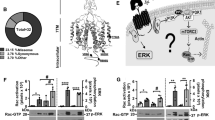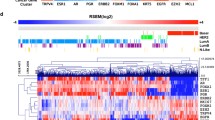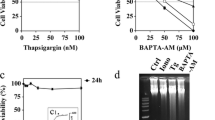Abstract
Store-operated Ca2+ entry is a pathway that is remodelled in a variety of cancers, and altered expression of the components of store-operated Ca2+ entry is a feature of breast cancer cells of the basal molecular subtype. Studies of store-operated Ca2+ entry in breast cancer cells have used non-specific pharmacological inhibitors, complete depletion of intracellular Ca2+ stores and have mostly focused on MDA-MB-231 cells (a basal B breast cancer cell line). These studies compared the effects of the selective store-operated Ca2+ entry inhibitors Synta66 and YM58483 (also known as BTP2) on global cytosolic free Ca2+ ([Ca2+]CYT) changes induced by physiological stimuli in a different breast cancer basal cell line model, MDA-MB-468. The effects of these agents on proliferation as well as serum and epidermal growth factor (EGF) induced migration were also assessed. Activation with the purinergic receptor activator adenosine triphosphate, produced a sustained increase in [Ca2+]CYT that was entirely dependent on store-operated Ca2+ entry. The protease activated receptor 2 activator, trypsin, and EGF also produced Ca2+ influx that was sensitive to both Synta66 and YM58483. Serum-activated migration of MDA-MB-468 breast cancer cells was sensitive to both store-operated Ca2+ inhibitors. However, proliferation and EGF-activated migration was differentially affected by Synta66 and YM58483. These studies highlight the need to define the exact mechanisms of action of different store-operated calcium entry inhibitors and the impact of such differences in the control of tumour progression pathways.






Similar content being viewed by others
Abbreviations
- ATP:
-
Adenosine triphosphate
- CM:
-
Complete media
- CPA:
-
Cyclopiazonic acid
- DMEM:
-
Dulbecco’s modified Eagle’s medium
- EGF:
-
Epidermal growth factor
- EGFR:
-
Epidermal growth factor receptor
- ER:
-
Endoplasmic reticulum
- FBS:
-
Foetal bovine serum
- IP3 :
-
Inositol 1,4,5-trisphosphate
- PAR2:
-
Protease-activated receptor 2
- PBS:
-
Phosphate-buffered saline
- PLC:
-
Phospholipase C
- SOCE:
-
Store-operated Ca2+ entry
- SRM:
-
Serum-reduced media
- STIM1:
-
Stromal interaction molecule 1
- STR:
-
Short tandem repeat
References
Putney JW (1986) A model for receptor-regulated calcium entry. Cell Calcium 7(1):1–12
Feske S, Gwack Y, Prakriya M, Srikanth S, Puppel SH, Tanasa B, Hogan PG, Lewis RS, Daly M, Rao A (2006) A mutation in Orai1 causes immune deficiency by abrogating CRAC channel function. Nature 441(7090):179–185
Lopez JJ, Albarran L, Gomez LJ, Smani T, Salido GM, Rosado JA (2016) Molecular modulators of store-operated calcium entry. Bba-Mol Cell Res 1863 8:2037–2043
Cai XY, Zhou YD, Nwokonko RM, Loktionova NA, Wang XM, Xin P, Trebak M, Wang YJ, Gill DL (2016) The Orai1 store-operated calcium channel functions as a hexamer. J Biol Chem 291(50):25764–25775
Putney JW, Steinckwich-Besancon N, Numaga-Tomita T, Davis FM, Desai PN, D’Agostin DM, Wu SL, Bird GS (2017) The functions of store-operated calcium channels. Bba-Mol Cell Res 1864 6:900–906
Fahrner M, Schindl R, Muik M, Derler I, Romanin C (2017) The STIM-Orai pathway: the interactions between STIM and Orai. Adv Exp Med Biol 993:59–81
Feske S (2009) ORAI1 and STIM1 deficiency in human and mice: roles of store-operated Ca2+ entry in the immune system and beyond. Immunol Rev 231:189–209
Davis FM, Janoshazi A, Janardhan KS, Steinckwich N, D’Agostin DM, Petranka JG, Desai PN, Roberts-Thomson SJ, Bird GS, Tucker DK, Fenton SE, Feske S, Monteith GR, Putney JW (2015) Essential role of Orai1 store-operated calcium channels in lactation. Proc Natl Acad Sci USA 112(18):5827–5832
Davis FM, Goulding EH, D’Agostin DM, Janardhan KS, Cummings CA, Bird GS, Eddy EM, Putney JW (2016) Male infertility in mice lacking the store-operated Ca2+ channel Orai1. Cell Calcium 59(4):189–197
Kar P, Parekh AB (2015) Distinct spatial Ca2+ signatures selectively activate different NFAT transcription factor isoforms. Acta Physiol 58(2):232–243
Prakriya M, Lewis RS (2015) Store-operated calcium channels. Physiol Rev 95(4):1383–1436
Wen L, Voronina S, Javed MA, Awais M, Szatmary P, Latawiec D, Chvanov M, Collier D, Huang W, Barrett J, Begg M, Stauderman K, Roos J, Grigoryev S, Ramos S, Rogers E, Whitten J, Velicelebi G, Dunn M, Tepikin AV, Criddle DN, Sutton R (2015) Inhibitors of ORAI1 prevent cytosolic calcium-associated injury of human pancreatic acinar cells and acute pancreatitis in 3 mouse models. Gastroenterology 149(2):481–492
Mai XY, Shang JY, Liang SJ, Yu BX, Yuan JN, Lin Y, Luo RF, Zhang FR, Liu YY, Lv XF, Li CL, Liang XL, Wang WD, Zhou JG (2016) Blockade of Orai1 store-operated calcium entry protects against renal fibrosis. J Am Soc Nephrol 27(10):3063–3078
Jardin I (1863) Rosado JA (2016) STIM and calcium channel complexes in cancer. Bba-Mol Cell Res 6:1418–1426
Sobradillo D, Hernandez-Morales M, Ubierna D, Moyer MP, Nunez L, Villalobos C (2014) A reciprocal shift in transient receptor potential channel 1 (TRPC1) and stromal interaction molecule 2 (STIM2) contributes to Ca2+ remodeling and cancer hallmarks in colorectal carcinoma cells. J Biol Chem 289(42):28765–28782
Tang BD, Xia X, Lv XF, Yu BX, Yuan JN, Mai XY, Shang JY, Zhou JG, Liang SJ, Pang RP (2017) Inhibition of Orai1-mediated Ca2+ entry enhances chemosensitivity of HepG2 hepatocarcinoma cells to 5-fluorouracil. J Cell Mol Med 21(5):904–915
Zhu H, Zhang H, Jin F, Fang MZ, Huang M, Yang CS, Chen T, Fu LW, Pan Z (2014) Elevated Orai1 expression mediates tumor-promoting intracellular Ca2+ oscillations in human esophageal squamous cell carcinoma. Oncotarget 5(11):3455–3471
Dubois C, Vanden AF, Lehen’kyi V, Gkika D, Guarmit B, Lepage G, Slomianny C, Borowiec AS, Bidaux G, Benahmed M, Shuba Y, Prevarskaya N (2014) Remodeling of channel-forming ORAI proteins determines an oncogenic switch in prostate cancer. Cancer Cell 26(1):19–32
McAndrew D, Grice DM, Peters AA, Davis FM, Stewart T, Rice M, Smart CE, Brown MA, Kenny PA, Roberts-Thomson SJ, Monteith GR (2011) ORAI1-mediated calcium influx in lactation and in breast cancer. Mol Cancer Ther 10(3):448–460
Motiani RK, Abdullaev IF, Trebak M (2010) A novel native store-operated calcium channel encoded by Orai3: selective requirement of Orai3 versus Orai1 in estrogen receptor-positive versus estrogen receptor-negative breast cancer cells. J Biol Chem 285(25):19173–19183
Kalimutho M, Parsons K, Mittal D, Lopez JA, Srihari S, Khanna KK (2015) Targeted therapies for triple-negative breast cancer: combating a stubborn disease. Trends Pharmacol Sci 36(12):822–846
Yang S, Zhang JJ, Huang XY (2009) Orai1 and STIM1 are critical for breast tumor cell migration and metastasis. Cancer Cell 15(2):124–134
Azimi I, Flanagan JU, Stevenson RJ, Inserra M, Vetter I, Monteith GR, Denny WA (2017) Evaluation of known and novel inhibitors of Orai1-mediated store operated Ca2+ entry in MDA-MB-231 breast cancer cells using a fluorescence imaging plate reader assay. Bioorg Med Chem 25(1):440–449
deFazio A, Chiew YE, Sini RL, Janes PW, Sutherland RL (2000) Expression of c-erbB receptors, heregulin and oestrogen receptor in human breast cell lines. Int J Cancer 87(4):487–498
Stemke-Hale K, Gonzalez-Angulo AM, Lluch A, Neve RM, Kuo WL, Davies M, Carey M, Hu Z, Guan Y, Sahin A, Symmans WF, Pusztai L, Nolden LK, Horlings H, Berns K, Hung MC, van de Vijver MJ, Valero V, Gray JW, Bernards R, Mills GB, Hennessy BT (2008) An integrative genomic and proteomic analysis of PIK3CA, PTEN, and AKT mutations in breast cancer. Cancer Res 68(15):6084–6091
Azimi I, Petersen RM, Thompson EW, Roberts-Thomson SJ, Monteith GR (2017) Hypoxia-induced reactive oxygen species mediate N-cadherin and SERPINE1 expression, EGFR signalling and motility in MDA-MB-468 breast cancer cells. Sci Rep 7(1):15140
Phuah SY, Looi LM, Hassan N, Rhodes A, Dean S, Taib NA, Yip CH, Teo SH (2012) Triple-negative breast cancer and PTEN (phosphatase and tensin homologue) loss are predictors of BRCA1 germline mutations in women with early-onset and familial breast cancer, but not in women with isolated late-onset breast cancer. Breast Cancer Res 14(6):R142
Changavi AA, Shashikala A, Ramji AS (2015) Epidermal growth factor receptor expression in triple negative and nontriple negative breast carcinomas. J Lab Phys 7(2):79–83
Cursons J, Leuchowius KJ, Waltham M, Tomaskovic-Crook E, Foroutan M, Bracken CP, Redfern A, Crampin EJ, Street I, Davis MJ, Thompson EW (2015) Stimulus-dependent differences in signalling regulate epithelial-mesenchymal plasticity and change the effects of drugs in breast cancer cell lines. Cell Commun Signal 13:26
Ye X, Weinberg RA (2015) Epithelial-mesenchymal plasticity: a central regulator of cancer progression. Trends Cell Biol 25(11):675–686
Stevenson RJ, Azimi I, Flanagan JU, Inserra M, Vetter I, Monteith GR, Denny WA (2018) An SAR study of hydroxy-trifluoromethylpyrazolines as inhibitors of Orai1-mediated store operated Ca2+ entry in MDA-MB-231 breast cancer cells using a convenient Fluorescence Imaging Plate Reader assay. Bioorg Med Chem 26(12):3406–3413
Wu TTL, Peters AA, Tan PT, Roberts-Thomson SJ, Monteith GR (2014) Consequences of activating the calcium-permeable ion channel TRPV1 in breast cancer cells with regulated TRPV1 expression. Cell Calcium 56(2):59–67
Kolch W, Pitt A (2010) Functional proteomics to dissect tyrosine kinase signalling pathways in cancer. Nat Rev Cancer 10(9):618–629
Burnstock G, Di VF (2013) Purinergic signalling and cancer. Purinerg. Signal 9(4):491–540
Takezawa R, Cheng H, Beck A, Ishikawa J, Launay P, Kubota H, Kinet JP, Fleig A, Yamada T, Penner R (2006) A pyrazole derivative potently inhibits lymphocyte Ca2+ influx and cytokine production by facilitating transient receptor potential melastatin 4 channel activity. Mol Pharmacol 69(4):1413–1420
Ng SW, di Capite J, Singaravelu K, Parekh AB (2008) Sustained activation of the tyrosine kinase Syk by antigen in mast cells requires local Ca2+ influx through Ca2+ release-activated Ca2+ channels. J Biol Chem 283(46):31348–31355
Di Sabatino A, Rovedatti L, Kaur R, Spencer JP, Brown JT, Morisset VD, Biancheri P, Leakey NA, Wilde JI, Scott L, Corazza GR, Lee K, Sengupta N, Knowles CH, Gunthorpe MJ, McLean PG, MacDonald TT, Kruidenier L (2009) Targeting gut T cell Ca2+ release-activated Ca2+ channels inhibits T cell cytokine production and T-box transcription factor T-bet in inflammatory bowel disease. J Immunol 183(5):3454–3462
Azimi I, Milevskiy MJG, Kaemmerer E, Turner D, Yapa KTDS, Brown MA, Thompson EW, Roberts-Thomson SJ, Monteith GR (2017) TRPC1 is a differential regulator of hypoxia-mediated events and Akt signalling in PTEN-deficient breast cancer cells. J Cell Sci 130(14):2292–2305
Neve RM, Chin K, Fridlyand J, Yeh J, Baehner FL, Fevr T, Clark L, Bayani N, Coppe JP, Tong F, Speed T, Spellman PT, DeVries S, Lapuk A, Wang NJ, Kuo WL, Stilwell JL, Pinkel D, Albertson DG, Waldman FM, McCormick F, Dickson RB, Johnson MD, Lippman M, Ethier S, Gazdar A, Gray JW (2006) A collection of breast cancer cell lines for the study of functionally distinct cancer subtypes. Cancer Cell 10(6):515–527
Polyak K, Weinberg RA (2009) Transitions between epithelial and mesenchymal states: acquisition of malignant and stem cell traits. Nat Rev Cancer 9(4):265–273
Azimi I, Monteith GR (2016) Plasma membrane ion channels and epithelial to mesenchymal transition in cancer cells. Endocr Relat Cancer 23(11):R517–R525
Davis FM, Peters AA, Grice DM, Cabot PJ, Parat MO, Roberts-Thomson SJ, Monteith GR (2012) Non-stimulated, agonist-stimulated and store-operated Ca2+ influx in MDA-MB-468 breast cancer cells and the effect of EGF-induced EMT on calcium entry. PLoS One 7(5):e36923
Li L, VanBreemen C (1996) Agonist- and CPA-induced elevation of cytoplasmic free Ca2+ in intact valvular endothelium from rabbits. Am J Physiol-Heart C 270(3):H837–H848
Azimi I, Beilby H, Davis FM, Marcial DL, Kenny PA, Thompson EW, Roberts-Thomson SJ, Monteith GR (2015) Altered purinergic receptor-Ca signaling associated with hypoxia-induced epithelial-mesenchymal transition in breast cancer cells. Mol Oncol 10(1):166–178
Bartkowiak K, Effenberger KE, Harder S, Andreas A, Buck F, Peter-Katalinic J, Pantel K, Brandt BH (2010) Discovery of a novel unfolded protein response phenotype of cancer stem/progenitor cells from the bone marrow of breast cancer patients. J Proteome Res 9(6):3158–3168
Davis FM, Azimi I, Faville RA, Peters AA, Jalink K, Putney JW Jr, Goodhill GJ, Thompson EW, Roberts-Thomson SJ, Monteith GR (2014) Induction of epithelial-mesenchymal transition (EMT) in breast cancer cells is calcium signal dependent. Oncogene 33(18):2307–2316
He LP, Hewavitharana T, Soboloff J, Spassova MA, Gill DL (2005) A functional link between store-operated and TRPC channels revealed by the 3,5-bis(trifluoromethyl)pyrazole derivative, BTP2. J Biol Chem 280(12):10997–11006
Putney JW (2010) Pharmacology of store-operated calcium channels. Mol Interv 10(4):209–218
Motiani RK, Hyzinski-Garcia MC, Zhang XX, Henkel MM, Abdullaev IF, Kuo YH, Matrougui K, Mongin AA, Trebak M (2013) STIM1 and Orai1 mediate CRAC channel activity and are essential for human glioblastoma invasion. Pflug Arch Eur J Physiol 465(9):1249–1260
Zhan ZY, Zhong LX, Feng M, Wang JF, Liu DB, Xiong JP (2015) Over-expression of Orai1 mediates cell proliferation and associates with poor prognosis in human non-small cell lung carcinoma. Int J Clin Exp Pathol 8(5):5080–5088
Jairaman A, Prakriya M (2013) Molecular pharmacology of store-operated CRAC channels. Channels 7(5):402–414
Zitt C, Strauss B, Schwarz EC, Spaeth N, Rast G, Hatzelmann A, Hoth M (2004) Potent inhibition of Ca2+ release-activated Ca2+ channels and T-lymphocyte activation by the pyrazole derivative BTP2. J Biol Chem 279(13):12427–12437
Acknowledgements
This research was partially supported by the National Health and Medical Research Council (NHMRC; project Grant 1079672). G.R.M. is supported by the Mater Foundation. The Translational Research Institute is supported by a Grant from the Australian Government.
Author information
Authors and Affiliations
Corresponding author
Ethics declarations
Conflict of interest
GR.M. and S.J.R.-T. are associated with QUE Oncology Inc.
Electronic supplementary material
Below is the link to the electronic supplementary material.
Rights and permissions
About this article
Cite this article
Azimi, I., Bong, A.H., Poo, G.X.H. et al. Pharmacological inhibition of store-operated calcium entry in MDA-MB-468 basal A breast cancer cells: consequences on calcium signalling, cell migration and proliferation. Cell. Mol. Life Sci. 75, 4525–4537 (2018). https://doi.org/10.1007/s00018-018-2904-y
Received:
Revised:
Accepted:
Published:
Issue Date:
DOI: https://doi.org/10.1007/s00018-018-2904-y




